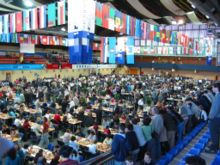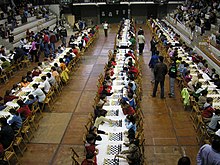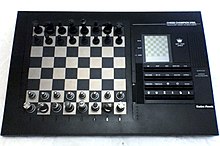
Chess is a board game for two players, called White and Black, each controlling an army of chess pieces in their color, with the objective to checkmate the opponent's king. It is sometimes called international chess or Western chess to distinguish it from related games such as xiangqi and shogi. The recorded history of chess goes back at least to the emergence of a similar game, chaturanga, in seventh century India. The rules of chess as they are known today emerged in Europe at the end of the 15th century, with standardization and universal acceptance by the end of the 19th century. Today, chess is one of the world's most popular games played by millions of people worldwide.

The rules of chess govern the play of the game of chess. Chess is a two-player abstract strategy board game. Each player controls sixteen pieces of six types on a chessboard. Each type of piece moves in a distinct way. The object of the game is to checkmate the opponent's king; checkmate occurs when a king is threatened with capture and has no escape. A game can end in various ways besides checkmate: a player can resign, and there are several ways a game can end in a draw.
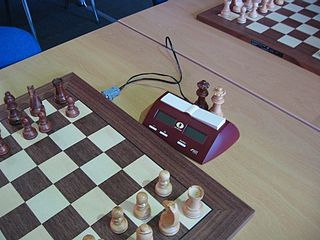
A time control is a mechanism in the tournament play of almost all two-player board games so that each round of the match can finish in a timely way and the tournament can proceed.
This glossary of chess explains commonly used terms in chess, in alphabetical order. Some of these terms have their own pages, like fork and pin. For a list of unorthodox chess pieces, see Fairy chess piece; for a list of terms specific to chess problems, see Glossary of chess problems; for a list of named opening lines, see List of chess openings; for a list of chess-related games, see List of chess variants; for a list of terms general to board games, see Glossary of board games.
In chess, there are a number of ways that a game can end in a draw, neither player winning. Draws are codified by various rules of chess including stalemate, threefold repetition, and the fifty-move rule. Under the standard FIDE rules, a draw also occurs in a dead position, most commonly when neither player has sufficient material to checkmate the opponent.
In chess, the threefold repetition rule states that a player may claim a draw if the same position occurs three times during the game. The rule is also known as repetition of position and, in the USCF rules, as triple occurrence of position. Two positions are by definition "the same" if the same types of pieces occupy the same squares, the same player has the move, the remaining castling rights are the same and the possibility to capture en passant is the same. The repeated positions need not occur in succession. The reasoning behind the rule is that if the position occurs three times, no real progress is being made and the game could hypothetically continue indefinitely.
A game of chess can end in a draw by agreement. A player may offer a draw at any stage of a game; if the opponent accepts, the game is a draw. In some competitions, draws by agreement are restricted; for example draw offers may be subject to the discretion of the arbiter, or may be forbidden before move 30, or even forbidden altogether. The majority of draws in chess are by agreement.

Fast chess, also known as speed chess, is a type of chess in which each player is given less time to consider their moves than classical chess time controls allow. Fast chess is subdivided, by decreasing time controls, into rapid chess, blitz chess, and bullet chess. Armageddon chess is a particular variation of fast chess in which different rules apply for each of the two players.

The 37th Chess Olympiad, organized by FIDE and comprising an open and a women's tournament, as well as several other events designed to promote the game of chess, took place between May 20 and June 4, 2006, in Turin, Italy. There were 148 teams in the open event and 103 in the women's event. In total, 1307 players were registered.
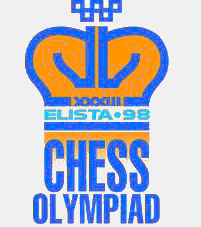
The 33rd Chess Olympiad, organized by FIDE and comprising an open and a women's tournament, took place between September 26 and October 13, 1998, in Elista, Kalmykia, Russia. There were 110 teams in the open event and 72 in the women's event.
Cheating in chess is a deliberate violation of the rules of chess or other behaviour that is intended to give an unfair advantage to a player or team. Cheating can occur in many forms and can take place before, during, or after a game. Commonly cited instances of cheating include: collusion with spectators or other players, use of chess engines during play, rating manipulation, and violations of the touch-move rule. Many suspiciously motivated practices are not comprehensively covered by the rules of chess.
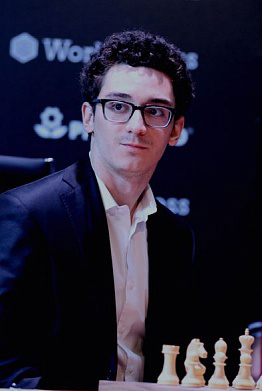
Fabiano Luigi Caruana is an Italian and American chess grandmaster who is the reigning US Chess Champion. With a peak rating of 2844, Caruana is the third-highest-rated player in history.
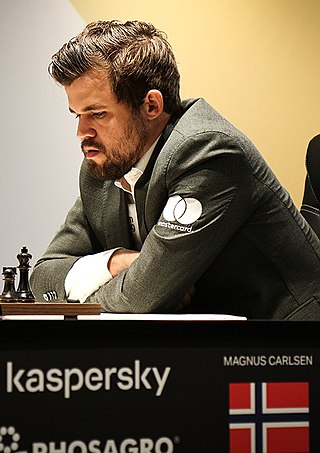
The World Blitz Chess Championship is a chess tournament held to determine the world champion in chess played under blitz time controls. Since 2012, FIDE has held an annual joint rapid and blitz chess tournament and billed it as the World Rapid & Blitz Chess Championships. The current world blitz champion is the Norwegian Grandmaster Magnus Carlsen. Bibisara Assaubayeva from Kazakhstan is the current women's blitz world champion. Magnus Carlsen has won the event a record six times.

The 39th Chess Olympiad, organised by FIDE and comprising an open and a women's tournament, as well as several other events designed to promote the game of chess, took place from September 19 to October 4, 2010 in Khanty-Mansiysk, Russia. There were 148 teams in the open event and 115 in the women's event. In total, 1306 players were registered.
In chess played with a time control, time trouble, time pressure, or its German translation Zeitnot, is the situation where a player has little time to complete the required moves. When forced to play quickly, the probability of making blunders is increased, so handling the clock is an important aspect of chess playing. The last move of the time control is especially prone to blunders if players only have a few seconds to play it, and many games have been lost due to poor time management in time pressure.

The 40th Chess Olympiad, organised by the Fédération Internationale des Échecs and comprising an open and women's tournament, as well as several events designed to promote the game of chess, was an international team chess event that took place in Istanbul, Turkey, from 27 August to 10 September 2012. The city also hosted the event in 2000.

The 42nd Chess Olympiad, organised by the Fédération Internationale des Échecs (FIDE) and comprising an open and women's tournaments, as well as several events designed to promote the game of chess, was an international team chess event held in Baku, Azerbaijan, from 1 to 14 September 2016. It was the first time that the Chess Olympiad had been hosted in Azerbaijan, the birthplace of former world champion Garry Kasparov; however, Azerbaijan had previously hosted strong tournaments, including the annual Shamkir Chess super-tournament in memory of Vugar Gashimov (1986–2014) and the Chess World Cup 2015.

The Chess World Cup 2017 was a 128-player single-elimination chess tournament, held in Tbilisi, Georgia, from 2 to 27 September 2017. It was won by Armenian grandmaster Levon Aronian. This was the second time he had won the Chess World Cup, 12 years after his first win in 2005. It was the 7th edition of the Chess World Cup.
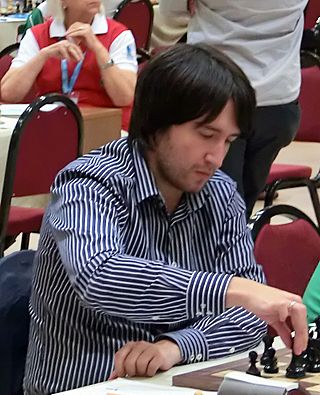
The Chess World Cup 2019 was a 128-player single-elimination chess tournament that took place in Khanty-Mansiysk, Russia, from 9 September to 4 October 2019. It was won by Azerbaijani grandmaster Teimour Radjabov. He and the runner-up, Ding Liren, both qualified for the Candidates Tournament for the World Chess Championship 2021. It was the 8th edition of the Chess World Cup.
